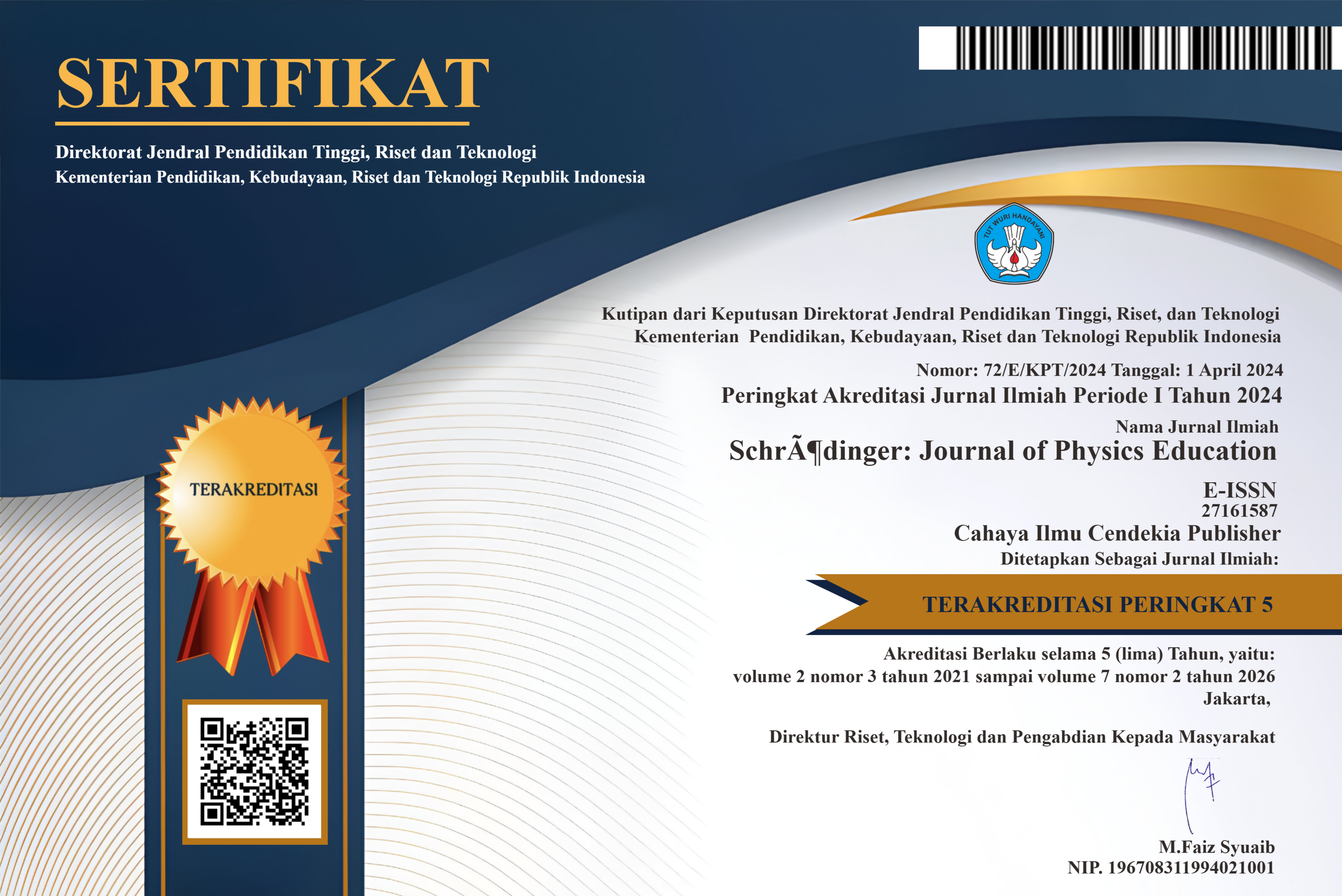Enhancing Student Learning Motivation in Physics Through Interactive Physics Education Technology (PhET) Simulation
Abstract
Purpose of the study: This research study aims to determine the effect of PhET simulation on the learning motivation of grade 12 STEM students in physics, specifically in projectile motion.
Methodology: This study employed a quasi-experimental research design. A convenience sampling technique was utilized with a sample size of thirty-three (n=33) senior high school Grade 12 STEM students from a private institution in Malolos, Bulacan. The quantitative data of this research was obtained through the Students Motivation Toward Physics Learning Questionnaire (SMTPLQ) and a semi-structured interview with random students. The data was analyzed using average mean, p-value, and paired-samples t-test using SPSS 22 software.
Main Findings: The learning motivation of the students in physics before the implementation of the PhET simulation was 3.82 (76.4%), which was medium-level motivation. After the implementation of the PhET simulation, the student's motivation in physics was 3.85 (77%), suggesting there was no statistically significant effect after using the PhET simulation. Despite no significant impact on motivation, students appreciated the engaging interaction with PhET simulations.
Novelty/Originality of this study: This research introduces a novel approach by integrating PhET simulations to enhance student learning motivation in physics. By leveraging interactive and engaging virtual experiments, this study aims to foster a deeper understanding and interest in physics concepts among students. Using PhET simulations offers a dynamic learning environment that encourages active participation and exploration, revitalizing traditional teaching methods.
References
D. Wangchuk, D. Wangdi, S. Tshomo, and J. Zangmo, “Exploring students’ perceived difficulties of learning physics,” Educ. Innov. Pract., vol. 6, May 2023, doi: 10.17102/eip.6.2023.03.
S. Y. Sari, F. R. Rahim, P. D. Sundari, and F. Aulia, “The importance of e-books in improving students’ skills in physics learning in the 21st century: a literature review,” J. Phys. Conf. Ser., vol. 2309, no. 1, p. 012061, Jul. 2022, doi: 10.1088/1742-6596/2309/1/012061.
E. Manlapig Jr, E. B. Acuña, and A. M. Manuel, “Exploring student academic performance and motivation in physics through electronic-strategic intervention material (e-SIM),” Int. J. Instr., vol. 9, no. 1, pp. 145–156, Apr. 2024, doi: 10.29333/aje.2024.9110a.
P. C. Hamerski, D. McPadden, M. D. Caballero, and P. W. Irving, “Students’ perspectives on computational challenges in physics class,” Phys. Rev. Phys. Educ. Res., vol. 18, no. 2, p. 020109, Aug. 2022, doi: 10.1103/PhysRevPhysEducRes.18.020109.
N. Safarati and F. Zuhra, “Use of problem-solving based physics comic media on global warming material in increasing learning motivation and students’ understanding concept,” J. Penelit. Pendidik. IPA, vol. 9, no. 11, pp. 9193–9199, Nov. 2023, doi: 10.29303/jppipa.v9i11.4828.
A. Alhadlaq, “Computer-based simulated learning activities: Exploring Saudi students’ attitude and experience of using simulations to facilitate unsupervised learning of science concepts,” Appl. Sci., vol. 13, no. 7, p. 4583, Apr. 2023, doi: 10.3390/app13074583.
H. J. Banda and J. Nzabahimana, “Effect of integrating physics education technology simulations on students’ conceptual understanding in physics: A review of literature,” Phys. Rev. Phys. Educ. Res., vol. 17, no. 2, p. 023108, Dec. 2021, doi: 10.1103/PhysRevPhysEducRes.17.023108.
K. Sage, S. Jackson, E. Fox, and L. Mauer, “The virtual COVID-19 classroom: surveying outcomes, individual differences, and technology use in college students,” Smart Learn. Environ., vol. 8, no. 1, p. 27, Dec. 2021, doi: 10.1186/s40561-021-00174-7.
E. Winter, A. Costello, M. O’Brien, and G. Hickey, “Teachers’ use of technology and the impact of Covid-19,” Ir. Educ. Stud., vol. 40, no. 2, pp. 235–246, Apr. 2021, doi: 10.1080/03323315.2021.1916559.
S. A. Courtney, M. E. S. Miller, and M. J. Gisondo, “The impact of COVID-19 on teachers’ integration of digital technology,” Contemp. Educ. Technol., vol. 14, no. 4, p. ep387, Sep. 2022, doi: 10.30935/cedtech/12420.
R. Holubova, “How to motivate our students to study physics?,” Univers. J. Educ. Res., vol. 3, no. 10, pp. 727–734, Oct. 2015, doi: 10.13189/ujer.2015.031011.
E. Nsabayezu et al., “Impact of computer-based simulations on students’ learning of organic chemistry in the selected secondary schools of Gicumbi District in Rwanda,” Educ. Inf. Technol., vol. 28, no. 3, pp. 3537–3555, Mar. 2023, doi: 10.1007/s10639-022-11344-6.
F. Almasri, “Simulations to teach science subjects: Connections among students’ engagement, self-confidence, satisfaction, and learning styles,” Educ. Inf. Technol., vol. 27, no. 5, pp. 7161–7181, Jun. 2022, doi: 10.1007/s10639-022-10940-w.
I. I. Salame and J. Makki, “Examining the Use of PhET Simulations on Students’ Attitudes and Learning in General Chemistry II,” Interdiscip. J. Environ. Sci. Educ., vol. 17, no. 4, p. e2247, May 2021, doi: 10.21601/ijese/10966.
C. A. Mrani, A. E. Hajjami, and K. E. Khattabi, “Effects of the integration of PhET simulations in the teaching and learning of the physical sciences of common core (Morocco),” Univers. J. Educ. Res., vol. 8, no. 7, pp. 3014–3025, Jul. 2020, doi: 10.13189/ujer.2020.080730.
R. Taibu, Ll. Mataka, and V. Shekoyan, “Using PhET simulations to improve scientific skills and attitudes of community college students,” Int. J. Educ. Math. Sci. Technol., vol. 9, no. 3, pp. 353–370, Apr. 2021, doi: 10.46328/ijemst.1214.
A. Gani, M. Syukri, K. Khairunnisak, M. Nazar, and R. P. Sari, “Improving concept understanding and motivation of learners through Phet simulation word,” J. Phys. Conf. Ser., vol. 1567, no. 4, p. 042013, Jun. 2020, doi: 10.1088/1742-6596/1567/4/042013.
W. Jannah, E. Evendi, S. Safrida, S. Ilyas, and M. Syukri, “Improvement of learning outcomes, motivation, and achievement of students’ social skills by applying student teams achievement division cooperative learning Model through PhET simulation media,” J. Penelit. Pendidik. IPA, vol. 7, no. 4, pp. 775–781, Oct. 2021, doi: 10.29303/jppipa.v7i4.796.
I. E. Prasetya, M. Yusuf, and T. J. Buhungo, “Description of students learning motivation towards the use of phet simulation in physics online learning in terms of self-efficacy and anxiety levels,” J. Pijar Mipa, vol. 17, no. 1, pp. 23–27, Jan. 2022, doi: 10.29303/jpm.v17i1.3218.
E. C. Prima, A. R. Putri, and N. Rustaman, “Learning solar system using PhET simulation to improve students’ understanding and motivation,” J. Sci. Learn., vol. 1, no. 2, p. 60, Mar. 2019, doi: 10.17509/jsl.v1i2.10239.
M. N. M. Najib, A. Yaacob, and R. Md-Ali, “Exploring the effectiveness of interactive simulation as blended learning approach in secondary school physics,” in International Academic Symposium of Social Science 2022, MDPI, Oct. 2022, p. 103. doi: 10.3390/proceedings2022082103.
L. Romano et al., “Minimally invasive gingival phenotype modification in gingival recession associated with a non‐carious cervical lesion using the root plastique technique: A quasi‐experimental one‐group pretest‐posttest study,” J. Periodontol., vol. 94, no. 5, pp. 641–651, May 2023, doi: 10.1002/JPER.22-0414.
U. A. Salikha, H. Sholihin, and N. Winarno, “The influence of STEM project-based learning on students’ motivation in heat transfer learning,” J. Phys. Conf. Ser., vol. 1806, no. 1, p. 012222, Mar. 2021, doi: 10.1088/1742-6596/1806/1/012222.
H. Tuan, C. Chin, and S. Shieh, “The development of a questionnaire to measure students’ motivation towards science learning,” Int. J. Sci. Educ., vol. 27, no. 6, pp. 639–654, Jan. 2005, doi: 10.1080/0950069042000323737.
P. Cavas, “Factors affecting the motivation of Turkish primary students for science learning,” Sci. Educ. Int., vol. 2, no. 1, pp. 31–42, 2011.
A. R. Albalate et al., “Students’ motivation towards science learning (STML) of stem students of University of Batangas, Lipa City,” PEOPLE Int. J. Soc. Sci., vol. 3, no. 3, pp. 1262–1274, Feb. 2019, doi: 10.20319/pijss.2018.33.12621274.
S. Kusairi, S. Imtinan, and P. Swasono, “Increasing students’ understanding in the concept of projectile motion with modelling instruction accompanied by embedded formative e-assessment,” J. Phys. Conf. Ser., vol. 1387, no. 1, p. 012081, Nov. 2019, doi: 10.1088/1742-6596/1387/1/012081.
R. J. Rafanan, C. Y. De Guzman, and D. Jr. Rogayan, “Pursuing STEM careers: Perspectives of senior high school students,” Particip. Educ. Res., vol. 7, no. 3, pp. 38–58, Dec. 2020, doi: 10.17275/per.20.34.7.3.
Melvin C. Eleo and Ylcy B. Manguilimotan, “Physics education technology (phet) interactive simulations as teaching aid in enhancing students’ performance in physics,” EPRA Int. J. Multidiscip. Res. IJMR, pp. 60–64, Mar. 2024, doi: 10.36713/epra15991.
B. Cheval et al., “Relationships between changes in self-reported physical activity, sedentary behaviour and health during the coronavirus (COVID-19) pandemic in France and Switzerland,” J. Sports Sci., vol. 39, no. 6, pp. 699–704, Mar. 2021, doi: 10.1080/02640414.2020.1841396.
T. K. Kim and J. H. Park, “More about the basic assumptions of t-test: normality and sample size,” Korean J. Anesthesiol., vol. 72, no. 4, pp. 331–335, Aug. 2019, doi: 10.4097/kja.d.18.00292.
P. Agyei, M. Abukari, P. Dorsah, T. Tindan, A. Najah, and I. Gonyalug, “PhET simulation instruction and its effects on students’ motivation to learn physics,” Lond. J. Press Ltd., vol. 23, no. 15, pp. 21–32.
D. Olugbade, S. S. Oyelere, and F. J. Agbo, “Enhancing junior secondary students’ learning outcomes in basic science and technology through PhET: A study in Nigeria,” Educ. Inf. Technol., Jan. 2024, doi: 10.1007/s10639-023-12391-3.
E. Pujono, F. Maulana, A. David, and B. Opeyemi, “Exploring Innovative approaches: optimizing google classroom for enhanced motivation in science learning”, Sch. Jo. Phs. Ed, vol. 5, no. 2, pp. 39-45, Jun. 2024, doi: 10.37251/sjpe.v5i2.965
M. Sulaiman, Yetti Latifah, Y. Deneri, and J. R. Gonzales, “Exploring character dynamics: Unveiling dominant values in physics education”, Sch. Jo. Phs. Ed, vol. 5, no. 2, pp. 46-52, Jun. 2024, doi: 10.37251/sjpe.v5i2.964
A. Fatonah, H. Worku, and F. Inyang, “Improving student learning outcomes on earth layers material by using audio visual media”, Sch. Jo. Phs. Ed, vol. 5, no. 2, pp. 53-61, Jun. 2024, doi: 10.37251/sjpe.v5i2.887
Copyright (c) 2024 Ernesto Manlapig

This work is licensed under a Creative Commons Attribution 4.0 International License.
Authors who publish with this journal agree to the following terms:
- Authors retain copyright and acknowledge that the Schrödinger: Journal of Physics Education is the first publisher licensed under a Creative Commons Attribution 4.0 International License.
- Authors are able to enter into separate, additional contractual arrangements for the non-exclusive distribution of the journal's published version of the work (e.g., post it to an institutional repository or publish it in a book), with an acknowledgment of its initial publication in this journal.
- Authors are permitted and encouraged to post their work online (e.g., in institutional repositories or on their website) prior to and during the submission process, as it can lead to productive exchanges and earlier and greater citation of published work.







.png)
.png)








.png)
.png)
.png)







